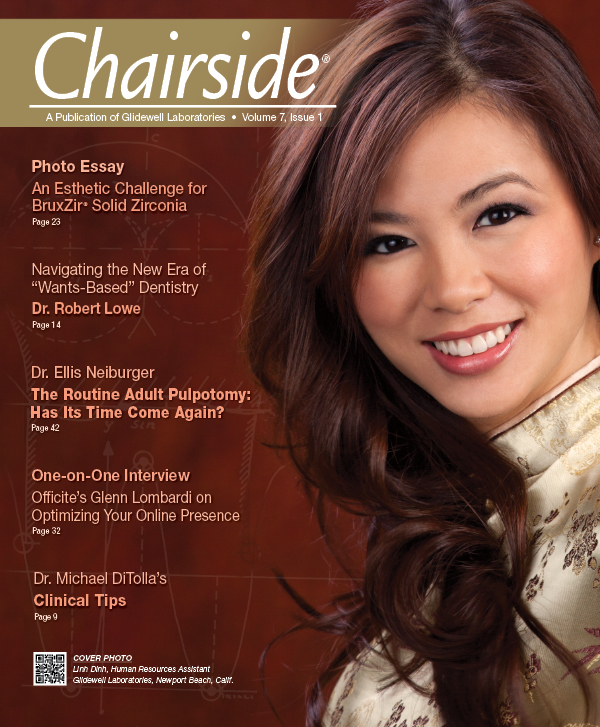Letters to the Editor
Dear Dr. DiTolla,
First of all, I want to thank you for helping me with anterior crown preps! I, too, find that as soon as I begin preparing, I lose my frame of reference. I have tried various depth measurement methods, but your Reverse Preparation Technique is priceless. Also, your in-depth video demonstration of its use is outstanding. Thank you so much for transforming my technique and for my newly gained confidence in accurately doing anterior crown preps in a timely manner.
I have a question for you: From the brief view I got of your dental unit on your video, it looks like you have an A-dec unit (Continental style). Also, the electric handpiece, if I viewed it correctly, is an A-dec/W&H electric motor. However, I noticed that you use the KaVo ELECTROtorque high-speed attachment. I did not know that KaVo electric handpieces were capable of connecting to A-dec/W&H electric motors. Do you need a special coupling/adaptor, or are you able to simply snap it on the same way you would if you used an A-dec/W&H electric handpiece? Also, I have the same A-dec unit plus A-dec/W&H electric motor, but I use the A-dec/W&H electric handpieces. I find them to be very good, but I must admit I have never tried the KaVo ELECTROtorque electric handpiece. Have you used or tried the A-dec/W&H electric handpiece? If so, how does it differ from the KaVo electric handpiece that you use?
Thank you very much for your time. Again, I enjoy watching and reviewing your instructional videos!
– Larry Kolar, DDS
Chicago, Ill.
Dear Larry,
Thanks for the kind words!
The KaVo electric handpieces do snap directly onto the A-dec motor; no adapter is needed. I have never used anything but KaVo handpieces, even going back to my air turbine days, so I guess that means I’ve been pretty satisfied with KaVo.
I know KaVo is doing a special promotion where, if you go to trykavo.com, they will send you an electric handpiece at no charge that you can snap on for a few days, prep some teeth and see which one you like better. Let me know what you think!
Best,
– Mike
Dear Dr. DiTolla,
I was wondering which is the strongest anterior bridge material besides monolithic zirconia? I have had failures with IPS Empress® II and IPS e.max® (Ivoclar Vivadent; Amherst, N.Y.). Fractures usually occur when patients unknowingly bite into a hard bone (meat that is supposed to be boneless), or forget they need to be cautious with the restorations and chomp on something like a hard baguette. The bridges in these cases have had solid, broad connectors. Could you comment on IPS e.max versus zirconia with layered porcelains (e.g., 3M™ ESPE™ Lava™ [St. Paul, Minn.])? Is it possible to make the lingual occlusion of an anterior maxillary bridge in zirconia and layer just the facial with porcelain, using the same concept of metal occlusion in a PFM? I am sitting on a case, so a quick response would be appreciated. Mahalo for your input.
– Dr. Todd Okazaki, DDS
Haleiwa, Hawaii
Dear Todd,
Good question! First of all, you are correct in thinking that monolithic zirconia, such as BruxZir® Solid Zirconia (Glidewell Laboratories; Newport Beach, Calif.), is the strongest all-ceramic bridge material that we have. This time last year, I would have hesitated to recommend that a dentist prescribe BruxZir Solid Zirconia for an anterior bridge. The esthetic nature of BruxZir restorations has really improved over the last year, although it hasn’t quite caught up with its monolithic brethren, such as IPS e.max. An anterior PFM bridge is probably the strongest solution, although the ceramic material can certainly chip off the metal understructure, and the esthetics can be compromised by the lack of translucency and possibly exposed metal margins.
I am not sure I would want to go with the zirconia-layered-with-ceramic option you mention, as we have noticed more chipping with that combination of materials than we have with porcelain fused to metal. In fact, porcelain fused to zirconia would probably be my last choice after BruxZir Solid Zirconia, IPS e.max and PFM.
You also asked about making the lingual of the bridge in solid zirconia, similar to a metal lingual on a PFM restoration. While we do fabricate bridges like that on request from dentists, we don’t get many requests for it. Perhaps the reason is that the strength of BruxZir Solid Zirconia comes from its monolithic nature — the fact that it doesn’t have any ceramic material fused to it. As a result, it fractures and/or chips less than any other restoration in the lab (except cast gold, of course). When we do make a BruxZir restoration like that, we typically place the ceramic material on the facial and carry it from the gingival down to the incisal edge, without wrapping the incisal edge. We want to allow the patient to function in protrusion on the zirconia, rather than the porcelain. But doing this takes it from being a monolithic BruxZir restoration to a bilayered restoration, which is more prone to chipping.
While there are no absolutes, my first choice today is IPS e.max for a 3-unit bridge in the anterior on a patient who does not show a lot of wear. For that same bridge in a patient who does show signs of wear, my choice is BruxZir Solid Zirconia, especially if the patient has previously chipped a PFM restoration. As the size of the bridge increases beyond 3 units, I begin to consider PFM as my choice because of the superior strength of the metal connectors when compared to any all-ceramic system, especially when there is a lack of room for the connectors. As always, your mileage may vary.
Hope that helps!
– Mike


